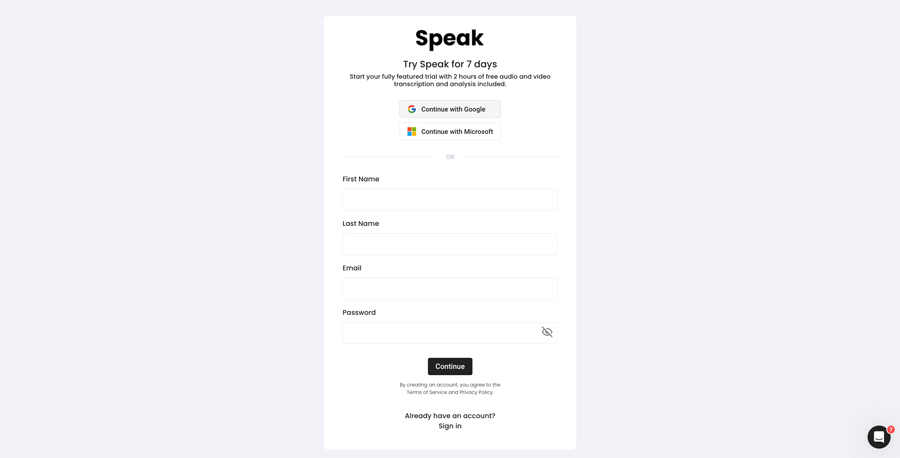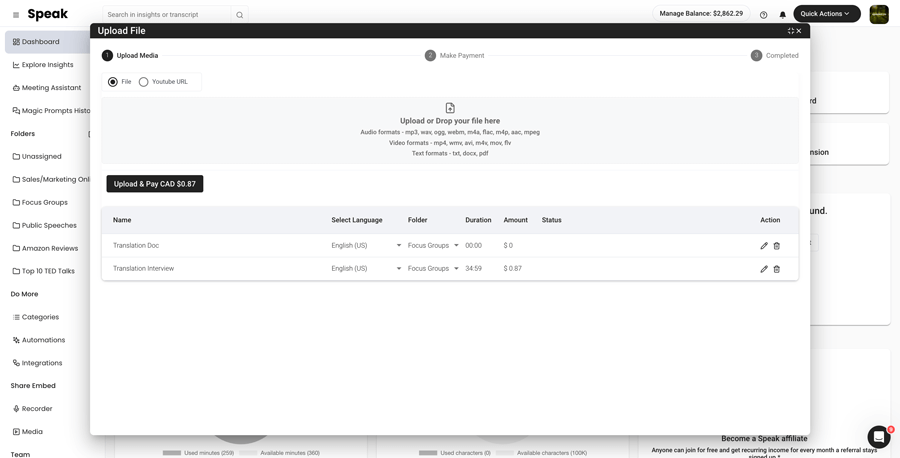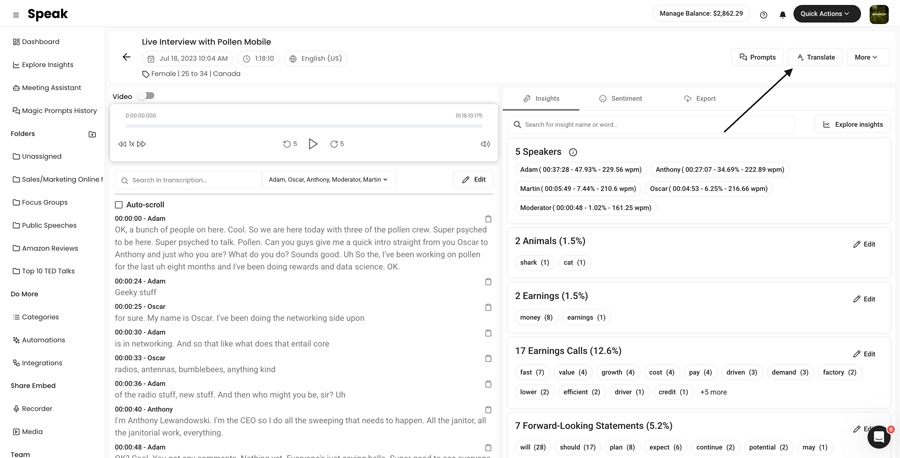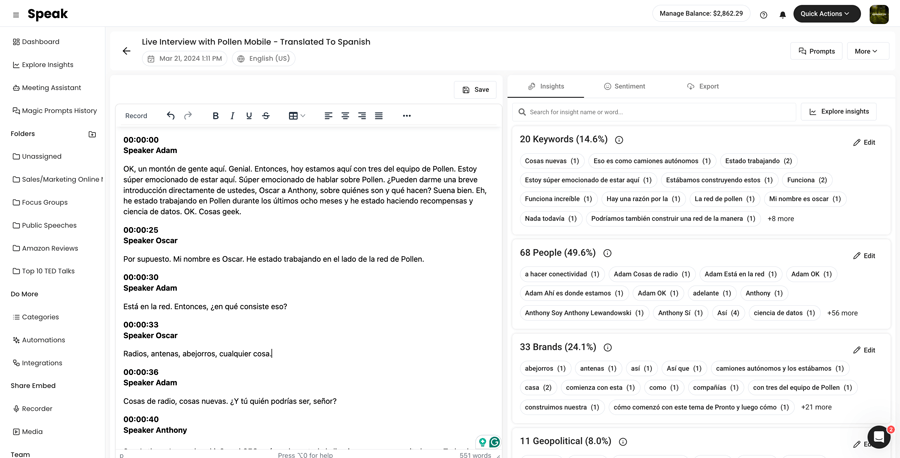How To Translate German to Chinese (Traditional)
Translating German to Chinese (Traditional) is super simple!

Step 1: Register for Speak
Register for Speak using this link.
Once you register, you can instantly begin translating your German to Chinese (Traditional) file(s).

Step 2: Upload Your German file(s)
As soon as you log in, you will be redirected to the dashboard.
Once there, you can select the Quick Action "New Upload".
In Speak, you can seamlessly upload, transcribe and translate audio, video and text files all at once!

Step 3: Translate Your German file(s) to Chinese (Traditional)
Once the file is uploaded, simply visit your file and select "Translate".
If it is an audio and video file, Speak will ask you if you want to keep the speaker names and timestamps in the translation.
Want to translate many files at once? No problem!
You can view the files you want to automatically translate from German to Chinese (Traditional) from the folder level and instantly translate as many files as you need with our artificial intelligence translation in just a few clicks.

Step 4: That's It! View, Analyze, Modify & Export Your New Chinese (Traditional) file(s)
Once the translation is done, you will be alerted and you will see a new document in the same folder your original file is in.
The file will be named the same but with a dash indicating that it is the translated version.
Need support with your German translation?
We are always here and happy to help at Speak!
Just send us a message on live chat on the bottom right corner and we will ensure you are set up for success.
Interested in translating German or other languages to different languages? View our entire list of supported translation languages here.
Automatic, accurate, instant AI translation from German to Chinese (Traditional) is here for you.
Register for Speak using this link and begin translating German to Chinese (Traditional) today.
Unlocking New Horizons: Translate German to Chinese (Traditional) with AI
As our world becomes increasingly interconnected, the ability to communicate across language barriers is more important than ever. For businesses and researchers looking to expand their horizons, understanding and leveraging the power of translation—specifically from German to Chinese (Traditional)—can transform opportunities and operations on a global scale. Speak AI, an industry leader in NLP and transcription software, is at the forefront of this transformative technology. With our advanced AI Meeting Assistant and integrations into platforms like Microsoft Teams, Zoom, Google Meet, and Webex, we offer a seamless, accurate, and efficient solution to bridge language divides.
The Strategic Edge of German to Chinese (Traditional) Translation
The world is teeming with linguistic diversity, making translation not just a necessity but a strategic advantage. For businesses and researchers operating between German and Chinese (Traditional) speaking environments, the ability to accurately translate documents, meetings, and communications can be a game-changer. It opens up new markets, accelerates research collaborations, and enhances understanding across cultures.
Applications in Commerce and Academia
Whether it's for closing deals, conducting market research, or sharing academic findings, automatic German to Chinese (Traditional) translation breaks down language barriers that often hinder progress. In commerce, it facilitates smoother negotiations and expands customer reach. Academically, it allows for the sharing of scientific discoveries and research across linguistic boundaries, enriching knowledge pools worldwide.
Cost and Time Efficiency
Traditional translation processes can be time-consuming and expensive. With Speak AI's automatic translation technology, businesses and researchers can drastically reduce both the time and cost associated with multilingual communication. This efficiency doesn’t just mean faster outcomes; it also reallocates resources to where they’re needed most, driving innovation and growth.
Why German to Chinese (Traditional)?
The significance of translating between German and Chinese (Traditional) stems from both languages' prominence in their respective fields and regions. German is widely known as the language of innovators and thinkers, holding strong in the realms of engineering, philosophy, and music. Conversely, Chinese (Traditional) carries cultural and economic weight across Taiwan, Hong Kong, and parts of Southeast Asia, marking it as a key language in global markets, particularly in technology and manufacturing industries.
Geographical and Statistical Insights
German is the most widely spoken native language in the European Union, with over 100 million speakers across Germany, Austria, Switzerland, and Belgium. On the other side of the globe, Chinese (Traditional) is used by millions, primarily in Taiwan and Hong Kong, serving as a gateway to engaging with vibrant cultures and booming economies.
Cultural Richness and Historical Depth
The linguistic landscape is not just about communication; it's also about culture. German literature and philosophy have shaped Western thought, while Chinese (Traditional) script ties to centuries of history and art, offering unmatched depth to explorers of culture and history.
Bridge Building Through Translation
At Speak AI, we understand the intricate dance of translation not just as a linguistic process but as an art and a science. Our AI-driven tools, backed by our substantial rating on G2 and a vibrant community of over 150K users, are designed to handle the nuances of German to Chinese (Traditional) translation. Here's how we do it:
Understanding Context and Culture
Our AI models are trained to grasp not just the words but the context behind them, ensuring that translations are not just accurate but contextually appropriate, preserving the intended message and cultural nuances.
Seamless Integration into Your Workflow
With Speak AI's meeting assistant, you can automatically transcribe and analyze discussions in German, translating them into Chinese (Traditional) in real-time, and vice versa. This makes every meeting, regardless of the linguistic backgrounds of the attendees, inclusive and productive.
The Future of Multilingual Dialogue
In an increasingly globalized world, the ability to navigate multiple languages is becoming a cornerstone of business and research success. Speak AI's translation technology doesn't just translate words; it bridges worlds, connecting German and Chinese (Traditional) speakers in a way that fosters understanding, collaboration, and progress. By integrating large language models, data visualization, and generative AI into our solutions, we are not just anticipating the future of communication—we are creating it.
Conclusion
Expanding your reach from German to Chinese (Traditional) opens up a universe of possibilities. Whether it's for business negotiations, academic collaborations, or understanding cultural nuances, Speak AI's translation tools are designed to empower you to communicate effectively and effortlessly. Join the ranks of our satisfied users and let us help you transcend language barriers to achieve your global objectives.
FAQs
Where are German and Chinese (Traditional) popular?
German is predominantly spoken in Germany, Austria, Switzerland, and parts of Belgium, making it a key language in Europe, while Chinese (Traditional) is primarily used in Taiwan, Hong Kong, and parts of Southeast Asia.
What are some fun facts about German and Chinese (Traditional)?
German has the longest word recorded in a dictionary, and Chinese (Traditional) characters are among the oldest continuously used scripts in the world. Both languages offer fascinating insights into their respective cultures and histories.
How do German and Chinese (Traditional) differ and what are their similarities?
While deriving from different language families, German and Chinese (Traditional) share a commitment to precision and clarity. The main difference lies in their script and phonetics, with German using the Latin alphabet and Chinese (Traditional) using logographic characters. Despite these differences, both languages convey rich histories and cultural nuances.
Embrace the future of communication with Speak AI. Our translation solutions are more than just tools—they are bridges to understanding, collaboration, and innovation. Start your journey today.
Translate German To These Other Supported Languages:
- Translate German-to-Arabic (Egypt)
- Translate German-to-Arabic (Iraq)
- Translate German-to-Arabic (Israel)
- Translate German-to-Arabic (Jordan)
- Translate German-to-Arabic (Kuwait)
- Translate German-to-Arabic (Lebanon)
- Translate German-to-Arabic (Oman)
- Translate German-to-Arabic (Palestinian Authority)
- Translate German-to-Arabic (Qatar)
- Translate German-to-Arabic (Saudi Arabia)
- Translate German-to-Arabic (Syrian Arab Republic)
- Translate German-to-Arabic (United Arab Emirates)
- Translate German-to-Arabic Modern Standard (Bahrain)
- Translate German-to-Armenian
- Translate German-to-Bulgarian
- Translate German-to-Catalan
- Translate German-to-Chinese (Cantonese, Traditional)
- Translate German-to-Chinese (Simplified)
- Translate German-to-Chinese (Traditional)
- Translate German-to-Croatian
- Translate German-to-Czech
- Translate German-to-Danish
- Translate German-to-Dutch
- Translate German-to-English
- Translate German-to-English (Australia)
- Translate German-to-English (India)
- Translate German-to-English (Ireland)
- Translate German-to-English (New Zealand)
- Translate German-to-English (Scottish)
- Translate German-to-English (South African)
- Translate German-to-English (United Kingdom)
- Translate German-to-English (United States)
- Translate German-to-Estonian
- Translate German-to-Farsi
- Translate German-to-Finnish
- Translate German-to-French
- Translate German-to-French (Canada)
- Translate German-to-German
- Translate German-to-German (Swiss)
- Translate German-to-Greek
- Translate German-to-Gujarati
- Translate German-to-Hebrew
- Translate German-to-Hindi
- Translate German-to-Hungarian
- Translate German-to-Icelandic
- Translate German-to-Indonesian
- Translate German-to-Irish
- Translate German-to-Italian
- Translate German-to-Japanese
- Translate German-to-Kannada
- Translate German-to-Korean
- Translate German-to-Latvian
- Translate German-to-Lithuanian
- Translate German-to-Malay
- Translate German-to-Malayalam
- Translate German-to-Norwegian
- Translate German-to-Persian
- Translate German-to-Polish
- Translate German-to-Portuguese
- Translate German-to-Portuguese (Brazilian)
- Translate German-to-Portuguese (Portugal)
- Translate German-to-Romanian
- Translate German-to-Russian
- Translate German-to-Slovak
- Translate German-to-Slovenian
- Translate German-to-Spanish
- Translate German-to-Spanish (Mexico)
- Translate German-to-Swedish
- Translate German-to-Tamil
- Translate German-to-Telugu
- Translate German-to-Thai
- Translate German-to-Turkish
- Translate German-to-Ukrainian
- Translate German-to-Vietnamese



